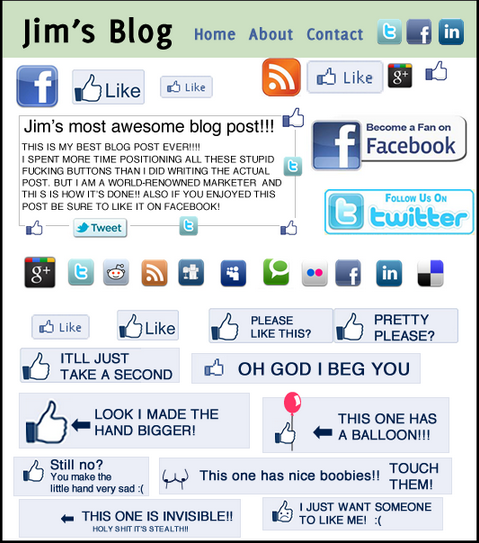There is no doubt that Facebook has changed a lot over the last 12 months.
I remember the days when Facebook pages looked completely different from profiles and the idea of having a cover photo was unheard of. Over the last few years, we’ve started to place more and more emphasis on generating likes on Facebook as a way to measure success. We strive to craft the perfect status update and study the differences between those that go viral on Facebook and those that fall flat.
While we chase the dream of having and creating an awesome Facebook page, many brands can’t make their Facebook marketing work. You might be making these mistakes or you’ve witnessed some of your favourite brands make them once or twice. Some of them are cringworthy while others can actually cost you the fans you’ve worked so hard to capture.
And while these mistakes are made by thousands around the world, the aren’t created equal. I’ve made many mistakes over the course of my career in digital marketing and social media but I’ve learned from them.
Why? Because mistakes are okay if you learn from them as a result.
Here are a few mistakes that you should try to avoid:
Liking Your Own Status Update
Sometimes brands have too many cooks in the kitchen, meaning too many admins on a Facebook page. Adding everyone and their daughter as a Facebook page admin a recipe for disaster. You might know more about Facebook than your boss and your boss might know more about Facebook than the client. It’s very rare that everyone is on the same page.
Because not everyone is on the same level of understanding, some admins press “like” as soon as they see their brands latest status update. Big mistake.
Instead of liking that page as an individual, you’re actually liking it as the brand. Meaning when a user looks at that status update they are going to see that “Your Brand Likes this” instead of “Your Name Likes this”. A brand liking their own status update is like giving yourself a self high five in public (Tweet this). Here’s how you avoid this mistake:
- Step One: Visit your brand pages Admin Panel
- Step Two: Click “change to [Your name]” below the search bar.
Likes Here. Likes There. Likes Everywhere.
I used to think that the most marketers valued the combination of art and science in their craft. Why? Because if you can combine the two of them, you will create not only something beautiful but also something effective.
Well, was I ever wrong!
I’ve helped everyone from startups to Fortune 100 companies with their Facebook pages and no matter the size of the business, it’s clear they all want likes. While you and I know that it’s the quality of a like that is more important than the quantity, this isn’t common industry knowledge.
Brands are currently in what I’d call a “Like-Frenzy”. You see billboards screaming “like us on Facebook” and websites that look very similar to this depiction from The Oatmeal:
Using Facebook call to actions when appropriate might be the most important point on this list. After all, there is no point pushing promoting your Facebook page when that very promotion is turning people off, right? Be simple with your call to actions and don’t go “like-crazy” just because you can. Less is more.
Connecting @Twitter to Your Facebook #Page
People are usually so excited to learn that they can connect Twitter and Facebook. Yes, I know you want to save time and be more efficient in the way you manage your social media presence but doing so at the expense of your audience is not a good call.
While it’s true that Facebook has recently integrated hashtags into their platform, it doesn’t mean you need to start using Facebook like it’s twitter. The way brands and people use hashtags on Facebook has yet to translate into the same way they use them on Twitter. As such, connecting Twitter and Facebook together doesn’t make sense just yet.
At the same time, users don’t want to subscribe to duplicate feeds. If you’re sharing something captivating and compelling, sure, sharing it on both channels makes sense. But sometimes, certain things are meant for twitter while others are meant for Facebook. Your fans don’t need to see a handful of customer service conversations on Facebook, they want to see unique and interesting content.
Conclusion
As I mentioned earlier, Facebook continues to change and it’s your job to keep up with it. Providing advice to your clients that don’t make them look stupid is just as important as making them go viral. At the same time, if you’re representing a brand and make a mistake or have made these mistakes in the past, that’s okay.
What’s not okay is accepting these failures and continuing to make the same mistakes over and over again. Strive to be better and you will see the benefits.
Have you run seen any other actions on Facebook that are cringe-worthy? If so, leave a comment explaining what you’ve seen!
(Photo from KWL on Flickr)



